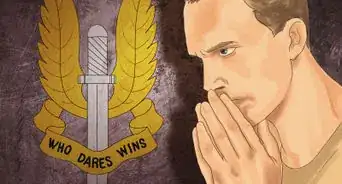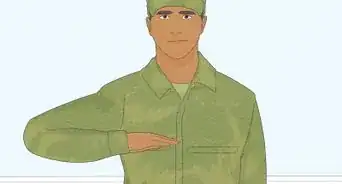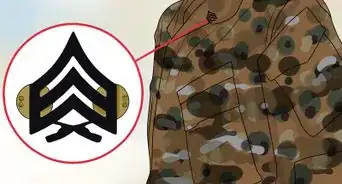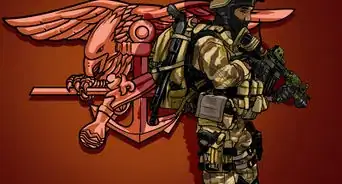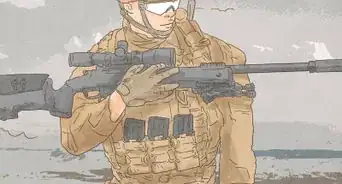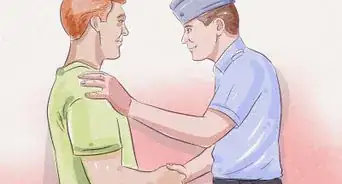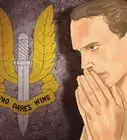wikiHow is a “wiki,” similar to Wikipedia, which means that many of our articles are co-written by multiple authors. To create this article, 26 people, some anonymous, worked to edit and improve it over time.
There are 8 references cited in this article, which can be found at the bottom of the page.
This article has been viewed 566,635 times.
Learn more...
U.S. Army uniforms and gear can vary based on rank and occasion. The easiest way to identity rank is to look for the insignia that each member of the Army will display on his or her uniform. Insignia will be unique to each rank, and the insignia of officers and generals will differ clearly from those of enlisted soldiers. Familiarizing yourself with these insignia will make it possible to quickly identify the rank of a member of the Army.
Steps
Identifying Enlisted Ranks
-
1Know where to look for insignia. Enlisted soldiers’ uniforms include the Army Combat Uniform (ACU), which is typically made of camouflaged print fabric, and the “Green” uniform, which is made of a heavy fabric coat and trousers or skirt. Insignia will be displayed on various places depending on the type of uniform:
- Look on the cap of an ACU. Enlisted soldiers display their rank insignia in the center of their caps.[1]
- A rank insignia patch will be sewn on the chest area of an ACU.
- The “Green” uniforms of enlisted soldiers have a rank insignia patch on the upper sleeves.[2]
- Enlisted soldiers do not display their rank insignia on their berets. Instead, the insignia of their unit will show on the front of the beret.[3]
-
2Learn the insignia of privates.[4] [5] The lowest rank (E-1) of enlisted soldiers, privates in Basic Combat Training (BCT), do not have insignia. Privates at the E-2 rank display a single yellow chevron. Soldiers at the Private First Class rank (PFC, E-3) wear a symbol of a chevron closed by a rounded bar at the bottom, enclosing a green field.Advertisement
-
3
-
4Distinguish sergeant insignia.[8] [9] There are a number of kinds of sergeants in the U.S. Army, at both enlisted and non-commissioned officer ranks. Paying close attention to their insignia will help you to distinguish them.
- A Sergeant’s (SGT, E-5) insignia is very similar to a corporal's, but shows three chevrons instead of two.
- A Staff Sergeant’s (SSG, E-6) insignia shows three chevrons closed by a rounded bar at the bottom, enclosing a green field.
- The insignia of a Sergeant First Class (SFC, E-7) is like a Staff Sergeant’s, but with two rounded bars at the bottom.
- A Master Sergeant’s (MSG, E-8) insignia is like a Sergeant First Class', but with three rounded bars at the bottom.
- A First Sergeant’s (1-SG, E-8) is like a Master Sergeant’s, with the addition of a small yellow diamond in the middle.
- A Sergeant Major (SGM, E-9) is like a First Sergeant’s, with a star in the middle instead of a diamond.
- A Command Sergeant Major (CSM, E-9) is like a First Sergeant’s, but two sheaves of wheat surrounding a star in the center instead of a diamond.
- The Sergeant Major of the Army’s (E-9) insignia is like a First Sergeant’s, but with a golden eagle and two stars in the middle instead of a diamond.
Identifying Officer Ranks
-
1Know where to look for insignia. Officer’s uniforms also include the Army Combat Uniform (ACU), which is typically made of camouflaged print fabric, and the “Green” uniform, which is made of a heavy fabric coat and trousers or skirt. Insignia will be displayed on various places depending on the type of uniform:
- Rank insignia is displayed in the center of an ACU cap.[10]
- A rank insignia patch will also be sewn on the chest area of an ACU.
- The “Green” uniforms of officers will show rank insignia on the shoulders.[11]
- An officer’s rank insignia will be displayed in the center of his or her beret, when one is worn.[12]
- Officer’s “Green” uniforms will have a black stripe on the outside of each trouser leg, as well as a black band on each sleeve just above the cuff.[13]
-
2Distinguish Lieutenant and Captain insignia.[14] [15] Second Lieutenants (2LT, O-1) , First Lieutenants (1LT, O-2) and Captain (CPT, O-3) all have bar-shaped insignia. A Second Lieutenant’s is a single gold bar, while the First Lieutenant’s is a single silver bar. A Captain’s (CPT, O-3) insignia is made up of two silver bars.
-
3
-
4
-
5Distinguish the insignia of Generals.[20] There are five ranks of generals in the U.S. Army. The insignia of each rank is made up of silver stars, so pay close attention to the different insignia to distinguish the ranks.
- A Brigadier General’s (BG, O-7) insignia is a single silver star.
- A Major General’s (MG, O-8) insignia is two silver stars side-by-side.
- A Lieutenant General’s (LTG, O-9) insignia is made of three silver stars side-by-side.
- A General’s (GEN, O-10) insignia is made of four silver stars side-by-side.
- General of the Army (GOA, O-11) insignia is made up of five stars arranged in a pentagon pattern. This rank is only used during certain wartime periods.
-
6Distinguish Warrant Officer Insignia.[21] [22] The insignia of the five ranks of Warrant Officer in the U.S. Army are all made of black blocks on a bar-shaped silver background. The insignia can be distinguished by the type and number of blocks.
- The insignia of a Warrant Officer 1 (WO1, W-1) is a single small black block in the center of a silver bar.
- The insignia of a Chief Warrant Officer 2 (CW2, W-2) is two black blocks in the center of a silver bar.
- The insignia of a Chief Warrant Officer 3 (CW3, W-3) is three black blocks in the center of a silver bar.
- The insignia of a Chief Warrant Officer 4 (CW4, W-4) is four black blocks in the center of a silver bar.
- The insignia of a Chief Warrant Officer 5 (CW5, W-5) is a single long black block running down the center of a silver bar.
Community Q&A
-
QuestionWhat do the letters "ISAF" mean?
 Community AnswerInternational Security Assistance Force. It's a component of NATO, currently being led by General John F. Campbell of the United States Army.
Community AnswerInternational Security Assistance Force. It's a component of NATO, currently being led by General John F. Campbell of the United States Army. -
QuestionWhat are the major military patches?
 Community AnswerThere are literally hundreds of different shoulder sleeve insignia (commonly referred to as "patches"). Worn on the left sleeve of the utility uniforms, they represent the Division or Brigade the soldier is assigned to. The ones on the right sleeve represent the unit in which the soldier served in combat for a period of six months or longer. Patches are not worn on the Army blue uniform. A metal device of the same design as the full-color patch of the former wartime unit is worn on the right breast pocket instead.
Community AnswerThere are literally hundreds of different shoulder sleeve insignia (commonly referred to as "patches"). Worn on the left sleeve of the utility uniforms, they represent the Division or Brigade the soldier is assigned to. The ones on the right sleeve represent the unit in which the soldier served in combat for a period of six months or longer. Patches are not worn on the Army blue uniform. A metal device of the same design as the full-color patch of the former wartime unit is worn on the right breast pocket instead. -
QuestionHow many stripes do generals have?
 Community AnswerGenerals don't have rank stripes. The only stripes they would have are service stripes or overseas bars.
Community AnswerGenerals don't have rank stripes. The only stripes they would have are service stripes or overseas bars.
References
- ↑ http://www.army.mil/symbols/combatflash.html
- ↑ http://www.army.mil/symbols/enlisteduniform.html
- ↑ http://www.army.mil/symbols/beret.html
- ↑ http://www.army.mil/symbols/enlisteddescriptions.html
- ↑ http://www.tecom.marines.mil/Portals/120/Docs/Student%20Materials/CREST%20Manual/RP0101.pdf
- ↑ http://www.army.mil/symbols/enlisteddescriptions.html
- ↑ http://www.tecom.marines.mil/Portals/120/Docs/Student%20Materials/CREST%20Manual/RP0101.pdf
- ↑ http://www.army.mil/symbols/enlisteddescriptions.html
- ↑ http://www.tecom.marines.mil/Portals/120/Docs/Student%20Materials/CREST%20Manual/RP0101.pdf
- ↑ http://www.army.mil/symbols/combatflash.html
- ↑ http://www.army.mil/symbols/enlisteduniform.html
- ↑ http://www.army.mil/symbols/beret.html
- ↑ http://www.army.mil/symbols/officeruniform.html
- ↑ http://www.army.mil/symbols/officerdescription.html
- ↑ http://www.tecom.marines.mil/Portals/120/Docs/Student%20Materials/CREST%20Manual/RP0101.pdf
- ↑ http://www.army.mil/symbols/officerdescription.html
- ↑ http://www.tecom.marines.mil/Portals/120/Docs/Student%20Materials/CREST%20Manual/RP0101.pdf
- ↑ http://www.army.mil/symbols/officerdescription.html
- ↑ http://www.tecom.marines.mil/Portals/120/Docs/Student%20Materials/CREST%20Manual/RP0101.pdf
- ↑ http://www.tecom.marines.mil/Portals/120/Docs/Student%20Materials/CREST%20Manual/RP0101.pdf
- ↑ http://www.army.mil/symbols/warrantdescription.html
- ↑ http://www.tecom.marines.mil/Portals/120/Docs/Student%20Materials/CREST%20Manual/RP0101.pdf
About This Article
To identify military rank in the U.S. Army, look for the insignia on the cap or shirt of a soldier's uniform. If they're displaying a single yellow chevron, they're at the E-2 rank. If their uniform has a yellow chevron with a rounded bar at the bottom, they're at the Private First Class rank. Specialists will have a green insignia with a golden eagle in the center, and corporals will display 2 yellow chevrons. If the soldier's insignia has more than 2 chevrons, they're likely a sergeant. To learn how to identify officer ranks in the U.S. Army, scroll down!
-Step-1-Version-4.webp)
-Step-2-Version-5.webp)
-Step-3-Version-4.webp)
-Step-4-Version-5.webp)
-Step-5-Version-4.webp)
-Step-6-Version-4.webp)
-Step-7-Version-4.webp)
-Step-8-Version-3.webp)
-Step-9-Version-4.webp)
-Step-10-Version-3.webp)

